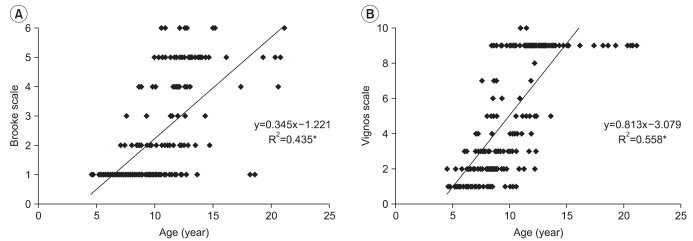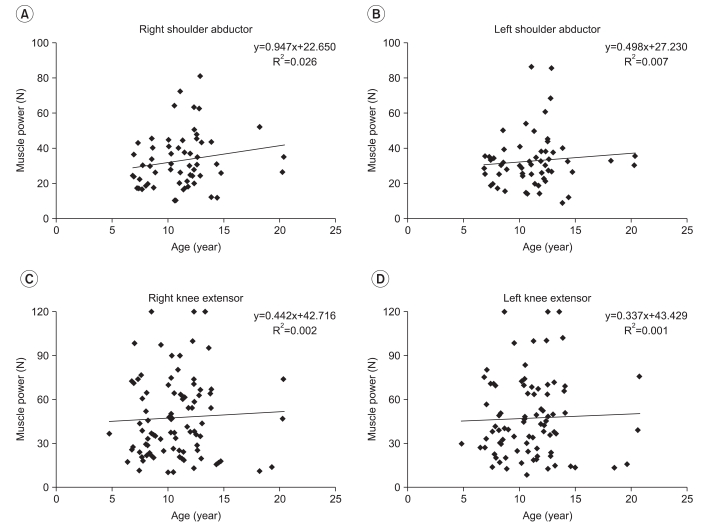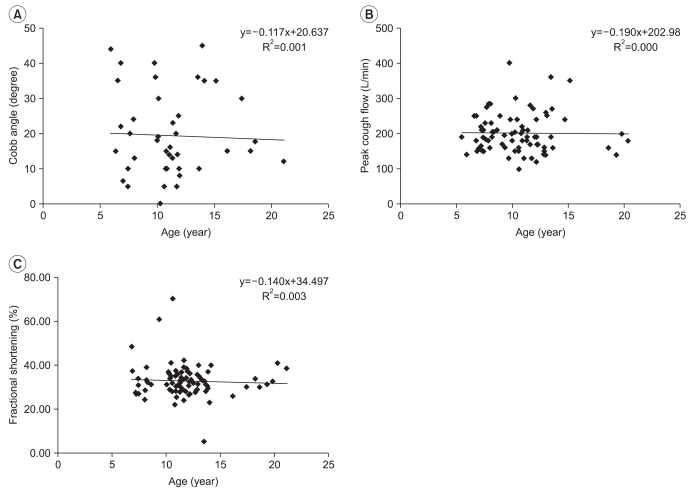Ann Rehabil Med.
2012 Feb;36(1):22-32. 10.5535/arm.2012.36.1.22.
The Correlation Analysis of Functional Factors and Age with Duchenne Muscular Dystrophy
- Affiliations
-
- 1Department of Rehabilitation Medicine, Seoul National University College of Medicine, Seoul 110-744, Korea. msbang@snu.ac.kr
- 2Department of Pediatrics, Seoul National University College of Medicine, Seoul 110-744, Korea.
- 3Department of Preventive Medicine, Seoul National University College of Medicine, Seoul 110-744, Korea.
- KMID: 2266777
- DOI: http://doi.org/10.5535/arm.2012.36.1.22
Abstract
OBJECTIVE
To correlate existing evaluation tools with clinical information on Duchenne muscular dystrophy (DMD) patients following age and to investigate genetic mutation and its relationship with clinical function. METHOD: The medical records of 121 children with DMD who had visited the pediatric rehabilitation clinic from 2006 to 2009 were reviewed. The mean patient age was 9.9+/-3.4 years and all subjects were male. Collected data included Brooke scale, Vignos scale, bilateral shoulder abductor and knee extensor muscles power, passive range of motion (PROM) of ankle dorsi-flexion, angle of scoliosis, peak cough flow (PCF), fractional shortening (FS), genetic abnormalities, and use of steroid.
RESULTS
The Brooke and Vignos scales were linearly increased with age (Brooke (y1), Vignos (y2), age (x), y1=0.345x-1.221, RBrooke2=0.435, y2=0.813x-3.079, RVignos2=0.558, p<0.001). In relation to the PROM of ankle dorsi-flexion, there was a linear decrease in both ankles (right and left R2=0.364, 0.372, p<0.001). Muscle power, Cobb angle, PCF, and FS showed diversity in their degrees, irrespective of age. The genetic test for dystrophin identified exon deletions in 58.0% (69/119), duplications in 9.2% (11/119), and no deletions or duplications in 32.8% (39/119). Statistically, the genetic abnormalities and use of steroid were not definitely associated with functional scale.
CONCLUSION
The Brooke scale, Vignos scale and PROM of ankle dorsi-flexion were partially available to assess DMD patients. However, this study demonstrates the limitations of preexisting scales and clinical parameters incomprehensively reflecting functional changes of DMD patients.
Keyword
MeSH Terms
Figure
Cited by 1 articles
-
A New Functional Scale and Ambulatory Functional Classification of Duchenne Muscular Dystrophy: Scale Development and Preliminary Analyses of Reliability and Validity
Jungyoon Kim, Il-Young Jung, Sang Jun Kim, Joong-Yub Lee, Sue Kyung Park, Hyung-Ik Shin, Moon Suk Bang
Ann Rehabil Med. 2018;42(5):690-701. doi: 10.5535/arm.2018.42.5.690.
Reference
-
1. Bushby K, Finkel R, Birnkrant DJ, Case LE, Clemens PR, Cripe L, Kaul A, Kinnett K, McDonald C, Pandya S, et al. Diagnosis and management of Duchenne muscular dystrophy, part 1: diagnosis, and pharmacological and psychosocial management. Lancet Neurol. 2010; 9:77–93. PMID: 19945913.
Article2. Elbrink J, Malhotra SK. The pathogenesis of Duchenne muscular dystrophy: significance of experimental observations. Med Hypotheses. 1985; 17:375–385. PMID: 4046906.
Article3. Deconinck N, Dan B. Pathophysiology of duchenne muscular dystrophy: current hypotheses. Pediatr Neurol. 2007; 36:1–7. PMID: 17162189.
Article4. Hoogerwaard EM, Bakker E, Ippel PF, Oosterwijk JC, Majoor-Krakauer DF, Leschot NJ, Van Essen AJ, Brunner HG, van der Wouw PA, Wilde AA, et al. Signs and symptoms of Duchenne muscular dystrophy and Becker muscular dystrophy among carriers in The Netherlands: a cohort study. Lancet. 1999; 353:2116–2119. PMID: 10382696.
Article5. Moon JH, Park YG, Park JS, Na YM, Kim YJ, Kang SW. Clinical profile of Duchenne muscular dystrophy. J Korean Acad Rehabil Med. 2001; 25:241–248.6. Madorsky JG, Radford LM, Neumann EM. Psychosocial aspects of death and dying in Duchenne muscular dystrophy. Arch Phys Med Rehabil. 1984; 65:79–82. PMID: 6696607.7. Karol LA. Scoliosis in patients with Duchenne muscular dystrophy. J Bone Joint Surg Am. 2007; 89(Suppl 1):155–162. PMID: 17272432.
Article8. Sasaki K, Sakata K, Kachi E, Hirata S, Ishihara T, Ishikawa K. Sequential changes in cardiac structure and function in patients with Duchenne type muscular dystrophy: a two-dimensional echocardiographic study. Am Heart J. 1998; 135:937–944. PMID: 9630096.
Article9. Romfh A, McNally EM. Cardiac assessment in Duchenne and Becker muscular dystrophies. Curr Heart Fail Rep. 2010; 7:212–218. PMID: 20857240.
Article10. Muntoni F. Cardiomyopathy in muscular dystrophies. Curr Opin Neurol. 2003; 16:577–583. PMID: 14501841.
Article11. Finsterer J. Cardiopulmonary support in Duchenne muscular dystrophy. Lung. 2006; 184:205–215. PMID: 17006747.
Article12. Houde S, Filiatrault M, Fournier A, Dube J, D'Arcy S, Berube D, Brousseau Y, Lapierre G, Vanasse M. Deflazacort use in Duchenne muscular dystrophy: an 8-year follow-up. Pediatr Neurol. 2008; 38:200–206. PMID: 18279756.
Article13. Angelini C, Pegoraro E, Turella E, Intino MT, Pini A, Costa C. Deflazacort in Duchenne dystrophy: study of long-term effect. Muscle Nerve. 1994; 17:386–391. PMID: 8170484.
Article14. Eagle M. Report on the muscular dystrophy campaign workshop: exercise in neuromuscular diseases Newcastle, January 2002. Neuromuscul Disord. 2002; 12:975–983. PMID: 12467755.
Article15. Bach JR, Martinez D, Saulat B. Duchenne muscular dystrophy: the effect of glucocorticoids on ventilator use and ambulation. Am J Phys Med Rehabil. 2010; 89:620–624. PMID: 20647779.16. Guglieri M, Bushby K. Molecular treatments in Duchenne muscular dystrophy. Curr Opin Pharmacol. 2010; 10:331–337. PMID: 20434401.
Article17. Wang Z, Chamberlain JS, Tapscott SJ, Storb R. Gene therapy in large animal models of muscular dystrophy. ILAR J. 2009; 50:187–198. PMID: 19293461.
Article18. Nelson SF, Crosbie RH, Miceli MC, Spencer MJ. Emerging genetic therapies to treat Duchenne muscular dystrophy. Curr Opin Neurol. 2009; 22:532–538. PMID: 19745732.
Article19. Brooke MH, Griggs RC, Mendell JR, Fenichel GM, Shumate JB, Pellegrino RJ. Clinical trial in Duchenne dystrophy. I. The design of the protocol. Muscle Nerve. 1981; 4:186–197. PMID: 7017401.
Article20. Lue YJ, Su CY, Yang RC, Su WL, Lu YM, Lin RF, Chen SS. Development and validation of a muscular dystrophy-specific functional rating scale. Clin Rehabil. 2006; 20:804–817. PMID: 17005504.
Article21. Bakker JP, De Groot IJ, Beelen A, Lankhorst GJ. Predictive factors of cessation of ambulation in patients with Duchenne muscular dystrophy. Am J Phys Med Rehabil. 2002; 81:906–912. PMID: 12447089.
Article22. Main M, Mercuri E, Haliloglu G, Baker R, Kinali M, Muntoni F. Serial casting of the ankles in Duchenne muscular dystrophy: can it be an alternative to surgery? Neuromuscul Disord. 2007; 17:227–230. PMID: 17303425.
Article23. Rose KJ, Burns J, Wheeler DM, North KN. Interventions for increasing ankle range of motion in patients with neuromuscular disease. Cochrane Database Syst Rev. 2010; 2:CD006973. PMID: 20166090.
Article24. Parreira SL, Resende MB, Della Corte Peduto M, Marie SK, Carvalho MS, Reed UC. Quantification of muscle strength and motor ability in patients with Duchenne muscular dystrophy on steroid therapy. Arq Neuropsiquiatr. 2007; 65:245–250. PMID: 17607422.
Article25. Palmieri B, Sblendorio V, Ferrari A, Pietrobelli A. Duchenne muscle activity evaluation and muscle func tion preservation: is it possible a prophylactic strategy? Obes Rev. 2008; 9:121–139. PMID: 18034791.26. Heller KD, Wirtz DC, Siebert CH, Forst R. Spinal stabilization in Duchenne muscular dystrophy: principles of treatment and record of 31 operative treated cases. J Pediatr Orthop B. 2001; 10:18–24. PMID: 11269806.
Article27. Cheuk DK, Wong V, Wraige E, Baxter P, Cole A, N'Diaye T, Mayowe V. Surgery for scoliosis in Duchenne muscular dystrophy. Cochrane Database Syst Rev. 2007; 1:CD005375. PMID: 17253553.
Article28. Kinali M, Messina S, Mercuri E, Lehovsky J, Edge G, Manzur AY, Muntoni F. Management of scoliosis in Duchenne muscular dystrophy: a large 10-year retrospective study. Dev Med Child Neurol. 2006; 48:513–518. PMID: 16700946.
Article29. Matecki S, Topin N, Hayot M, Rivier F, Echenne B, Prefaut C, Ramonatxo M. A standardized method for the evaluation of respiratory muscle endurance in patients with Duchenne muscular dystrophy. Neuromuscul Disord. 2001; 11:171–177. PMID: 11257474.
Article30. Phillips MF, Quinlivan RC, Edwards RH, Calverley PM. Changes in spirometry over time as a prognostic marker in patients with Duchenne muscular dystrophy. Am J Respir Crit Care Med. 2001; 164:2191–2194. PMID: 11751186.
Article31. Corrado G, Lissoni A, Beretta S, Terenghi L, Tadeo G, Foglia-Manzillo G, Tagliagambe LM, Spata M, Santarone M. Prognostic value of electrocardiograms, ventricular late potentials, ventricular arrhythmias, and left ventricular systolic dysfunction in patients with Duchenne muscular dystrophy. Am J Cardiol. 2002; 89:838–841. PMID: 11909570.
Article32. Mohyuddin T, Jacobs IB, Bahler RC. B-type natriuretic peptide and cardiac dysfunction in Duchenne muscular dystrophy. Int J Cardiol. 2007; 119:389–391. PMID: 17079036.
Article33. Beggs AH, Koenig M, Boyce FM, Kunkel LM. Detection of 98% of DMD/BMD gene deletions by polymerase chain reaction. Hum Genet. 1990; 86:45–48. PMID: 2253937.
Article34. Sellner LN, Taylor GR. MLPA and MAPH: new techniques for detection of gene deletions. Hum Mutat. 2004; 23:413–419. PMID: 15108271.
Article35. Nicholson LV, Johnson MA, Bushby KM, Gardner-Medwin D, Curtis A, Ginjaar IB, den Dunnen JT, Welch JL, Butler TJ, Bakker E, et al. Integrated study of 100 patients with Xp21 linked muscular dystrophy using clinical, genetic, immunochemical, and histopathological data. Part 2. Correlations within individual patients. J Med Genet. 1993; 30:737–744. PMID: 8411068.
Article36. Den Dunnen JT, Grootscholten PM, Bakker E, Blonden LA, Ginjaar HB, Wapenaar MC, van Paassen HM, van Broeckhoven C, Pearson PL, van Ommen GJ. Topography of the Duchenne muscular dystrophy (DMD) gene: FIGE and cDNA analysis of 194 cases reveals 115 deletions and 13 duplications. Am J Hum Genet. 1989; 45:835–847. PMID: 2573997.37. Roberts RG, Bobrow M, Bentley DR. Point mutations in the dystrophin gene. Proc Natl Acad Sci U S A. 1992; 89:2331–2335. PMID: 1549596.
Article38. Koenig M, Hoffman EP, Bertelson CJ, Monaco AP, Feener C, Kunkel LM. Complete cloning of the Duchenne muscular dystrophy (DMD) cDNA and preliminary genomic organization of the DMD gene in normal and affected individuals. Cell. 1987; 50:509–517. PMID: 3607877.
Article39. Forrest SM, Cross GS, Flint T, Speer A, Robson KJ, Davies KE. Further studies of gene deletions that cause Duchenne and Becker muscular dystrophies. Genomics. 1988; 2:109–114. PMID: 3410474.
Article40. Monaco AP, Bertelson CJ, Liechti-Gallati S, Moser H, Kunkel LM. An explanation for the phenotypic differences between patients bearing partial deletions of the DMD locus. Genomics. 1988; 2:90–95. PMID: 3384440.
Article41. Cho H, Hong JM, Lee KA, Choi YC. Clinical usefulness of molecular diagnosis in dystrophin gene mutations using the multiplex ligation-dependent probe amplification (MLPA) method. J Korean Neurol Assoc. 2010; 28:22–26.
- Full Text Links
- Actions
-
Cited
- CITED
-
- Close
- Share
- Similar articles
-
- A clinical study on Duchenne muscular dystrophy
- Clinical Implications of Pulmonary Function Test and Maximum Static Pressure in Duchenne Muscular Dystrophy
- Duchenne Muscular Dystrophy Complicated With Dilated Cardiomyopathy and Cerebral Infarction
- A Clinical Study on Duchenne Muscular Dystrophy in Childhood
- Duchenne Type Muscular Dystrophy: Report of 8 Cases





